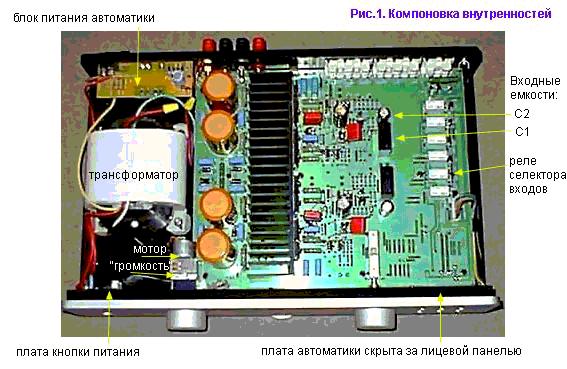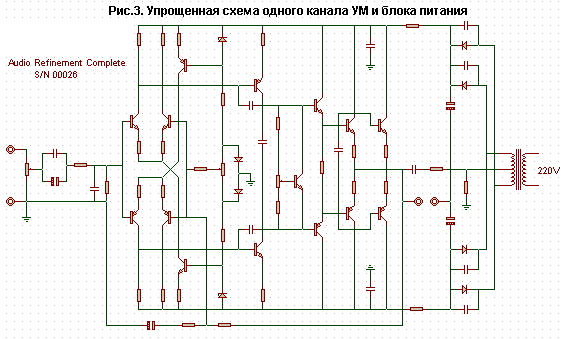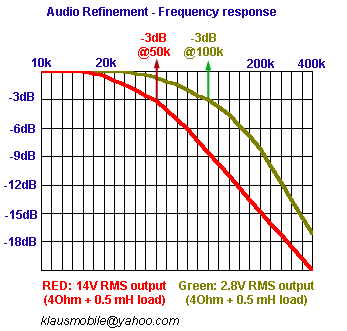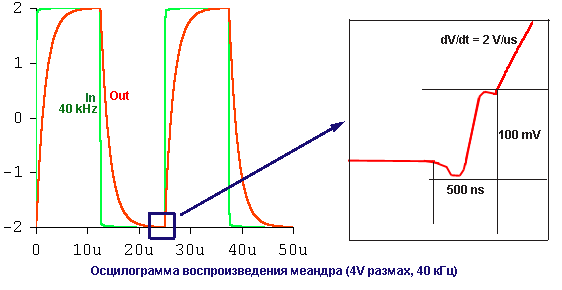Inside Story: Audio Refinement Complete integrated amplifier
(c) klausmobile 2000
'The Complete' is made to design by Yves-Bernard Andre (YBA). My unit s/n is an early 00026, probably later copies are different from the first batch. I used the amp for two years, and the only reason to dig inside it - apart from 'how they did it' curiosity, was to disconnect the volume pot motor. It returns to zero at each power down - quite a nuisance to set volume every time without remote.
1. First looks
You'll need a PH0 or PH1 screwdriver and a 2.5mm Allen key. Remove six Allen bolts under the bottom, slide back the top cover. Here's the picture

3/4 of the case space is taken by an audio PCB (about 22*30cm). A small, about 1200 cm2, heatsink is bolted to the PCB, which is perforated under the heatsink. There's a total of 8 power devices for both channels. Power transformer looks very impressive - circular cross-section O-core, heavy gauge copper secondaries. Secondaries, rectifiers (BY255) and filter caps (ROE 4700 uF 63V per leg) are independent for each channel. Diodes and main caps are bypassed by small Wima MKP propylene caps (blue on photo).
There's three other boards. One (above the audio transformer) for a small 12V transformer and rectifier powering the remote control board. This is powered continuously regardless of front plate power button. The second - for the front plate power button and a 220V relay - right behind the button. The third - remote control and input selector logic - behind the right half of front plate.
Huge audio board space allows the designers to space all components at least 5mm apart, not the 2.5mm as usual (except the driver stage compensation caps that are soldered directly to base-collector pins). Input cap C1 is a grey (black on the photo) matchbox with 'YBA 10uF 160V' print, probably polypropylene (too small for a polystyrene). It is bypassed by a C2 - 470 uF 63V electrolytic. From this point further, the amp is DC-coupled. Other audio caps are Wima MKP (polypropylene). There's a few unused slots for electrolytic and film caps, apparently for the input/driver stage filter. But they are unused, even in recently built units.
OK, I cut the motor wires, time to decypher the board. Actually, most of it can be done without looking on the PCB other side. The schematic is a uniquitous dual differential input, - used in at least 75% of car audio amps (that's my business). Strangely, they don't sound like YBA does :)).
BTW. You won't see part numbers for output transistors. That is, they are sanded away (as well as IC marking on the remote board). All I can say is that pre-outs are TO220 (no heatsink), and output devices are TO247 package. There are pencil marks on them - 29,30,31,32. If you can guess what it means, read further.
2. Removing the board
Loosen two screws holding a small brass cylinder on the input selector shaft. Remove selector and volume knobs. Behind each knob are two screws. They hold the faceplate to chassis. Remove the faceplate. Ha-ha-ha, I didn't tell you - the pushbuttons dropped all around the floor - there's nothing to secure them from behind. Pick up the buttons. Remove the screws holding plastic flanges for the volume pot and input selector. Remove the screws holding rear panel (careful, don't damage the RCA sockets soldered to the PCB). Remove brass Allen screws holding the PCB to plasttic inserts in the chassis. Remove the remote control plug from the PCB.
The PCB remains tethered to the chassis by wires to the transformer, volume motor wires, and speaker outputs. After cutting motor wires, you can slide it back and turn vertically for inspection. Well, the PCB bottom looks very impressive - smart routing, massive solder joints, all traces generously spaced apart.
3. Have you seen the circuit before?
Here's one channel full schematic 3-digit part codes match the PCB marking (1** left, 2** right), 2-digit codes don't.

No preamp as such. Signal flows through selector relays, to the volume pot (dual motorized Alps), then to input capacitors and a 150 kHz low-pass. Then goes the ubiquitous dual differential. No protection of any kind results in a strong plop on powerup. And pretty high gain, judging bu feedback resistors. Which, incidentally, means lesser feedback.
With top cover removed, temperature sets in less than 10 minutes. When idle, pre-output transistors (biased to 17 mA) are very hot, 80C (and more with top cover down). Output is biased to 40..50 mA per device. Rail voltage (idle) is +/- 38..43V depending on mains 210..240V.
4. Measurements
All measurements where made to 4.3 Ohm + 0.5 mH dummy loads in both channels, driven in phase. My oscillator produces sinewave as low as 0.01 Hz, but as for the square pulse - it appears to have a 5Hz high-pass so even the midbass pulses look squished. So any LF pulse response notes are a comparison between dumb and dumber.

Treble response in nonlinear - for low-level signal it expands higher than for high-level. High-level response is a straight 1-order @50kHz, low-level is apparently a higher order function (F3@100kHz). This I presume explains 'treble compression'. Apart from this, response is linear down to 5Hz (which is my bench limit, not the amp's).
Seems that the designer deliberately tuned the amp this way. Otherwise, why such a high gain, why use very slow transistors in the driver stage (MJE340, 350 - Motorola even doesn't publish frequency specs on them). Seems completely nonsense, yet sounds good.
Power tests were upsetting. Clipping at 15V RMS (20-1000 Hz, slightly better at higher frequencuies where load is easier) means 45 WPC into 4 Ohm. Not the 90, quoted on the Net - interesting, neither the Phlox-YBA site nor the manual say anything about output to 4 Ohm.

Square tests: low level pulse shows a signature transient distortion. It starts at Vout>200mV (entering the AB class zone), then the transient glitch quickly reaches 100 mV p-p, and remains stable (100mV-500ns) regardless of voltage and frequency up to 100 kHz. When the output pulse degenerates into triangle wave, this glitch disappears. The pulse shape in whole looks exactly like 1 order high pass. Max slew rate - 8V/us, as goos as my bench tools are.
5. Speaking of sound
Here's my review posted at www.audioasylum.com
For two years I use A.R. as the only amp for music and video. The unit s/n is an early 00026, and judging by two many empty slots on the board, it might differ a lot from the newly made ones.
The sound is warm, open, and very comfortable. A/B tests with other amps (other things equal) show that A.R. somehow compresses the sound without losing too much detail or imaging. The voices sound more in harmony than they do on other equipment, and when the sudden loud solo on the other amp stands out and breaks the picture, with the A.R. it still stands out but as a part of the cohesive total. This applies not only to loudness and tonal harmony, but to tempo as well, believe it or not. The amplifier as a second conductor? I'd say, the designer sacrificed some fidelity in favor of musicality, or - to the critics - in favor of plain ear comfort. Euphonics, is it the right word?
Before you read further (for the bad news): this is a good amp that I'd keep for at least a few years more.
One thing where A.R. obviously fails, in my opinion, is how it renders string attack. It over-empasizes the attack, double bass, or violin pizzicato - and sometimes it sounds as if the recording was made close-mike in a small club while in fact it was a huge hall.
As for the other glitches. The most obvious two are related to the automated source selector and motorized volume - this is the weakest part of a design.
1. Volume returns to zero at each power off. I'm not using a remote, so I simply disconnected motor wires. You'd need a 2.5mm hex key to get inside.
2. Too much crosstalk from unused audio inputs to output. I'm thinking of re-wiring it completely, placing reed relays on separate daughterboards for each input - I need only three, with decent cables to source units running directly from the daughterboards - bypassing the rear RCA jacks.
3. The other side of #2, poor channel separation. Doesn't this explain in part the cohesive sound picture?
4. The pre-output follower transistors have no heatsinks and yes they get quite hot in less than three minutes (about 80C on tab with top cover removed). The main heatsink is mounted neatly but, again, can be not good enough for proper convection. I'm not sure if it could be a problem in places warmer than mine, or at higher output, - good ventilation is a must - not only above the case, but especially UNDER the case, where colder air is inhaled.
5. It bumps on power-on and breathes on power-off, not too loud on my speakers but might be painfully loud on high efficiency ones.
6. There is NO protection of any kind for the amp (short circuit kills) or the speakers.






